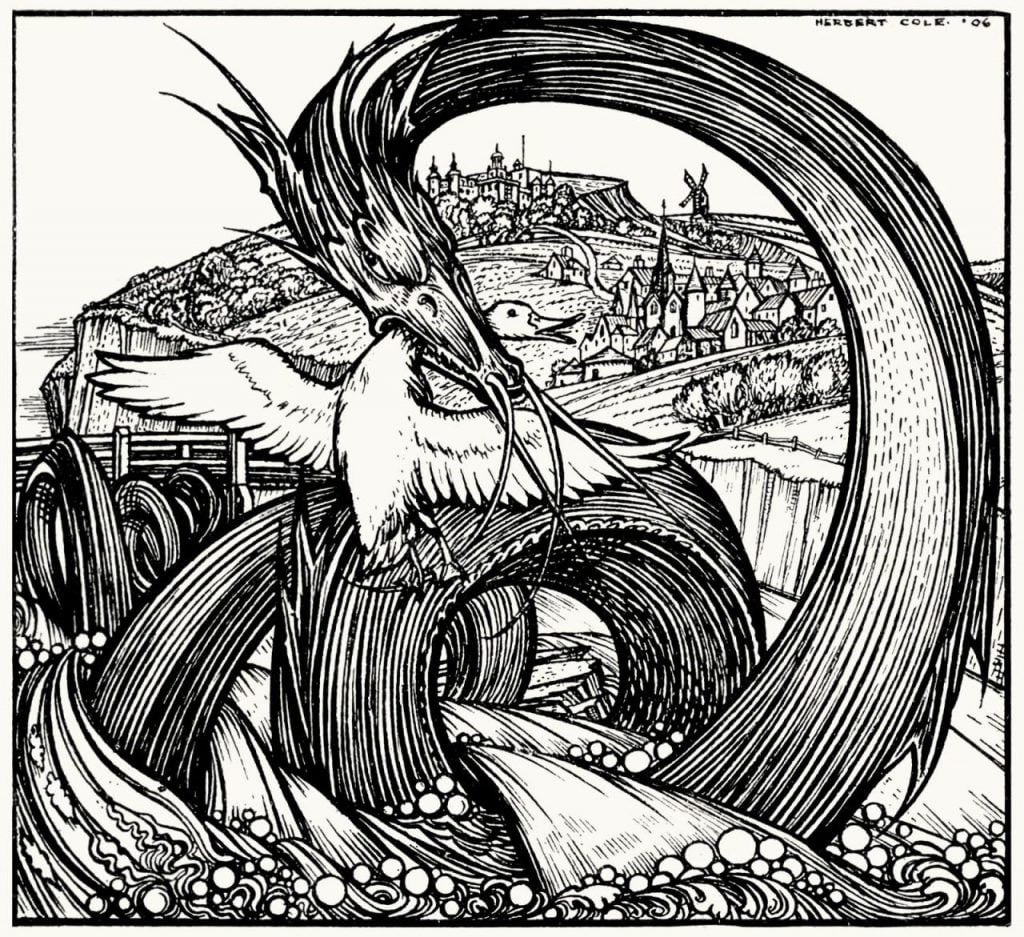Lambton Worm
“Local Heir Skips Church, Hooks River Monster, and Unleashes a Deadly Curse on His Family!”
Appearance
The Lambton Worm is described as a massive, serpentine creature with a fearsome, otherworldly presence. Its body is long and eel-like, covered in slimy, scale-like skin that glistens with a sickly green hue. Sharp, thorn-like ridges line its back, and its grotesquely wide mouth is filled with jagged, needle-sharp teeth. The worm’s red, glowing eyes are said to exude malice, and its coiling form is so immense that it could wrap itself multiple times around a hill.
Behavior
The Lambton Worm exhibits predatory and territorial behavior, fiercely dominating its environment. It is insatiable in its appetite, consuming livestock, crops, and even unwary humans. The worm has a sadistic streak, appearing to take pleasure in the fear it instills. It demonstrates a level of cunning, often demanding regular sacrifices from the terrified villagers to keep it appeased.
Habitat
Originally confined to a well near the River Wear, the Lambton Worm eventually expands its range to the surrounding countryside. Its primary haunt is Worm Hill, where it coils its immense body, creating an imposing and grotesque silhouette. The nearby river is its secondary domain, providing a strategic advantage for ambushing prey and retreating from threats.
Modus Operandi
The Lambton Worm employs intimidation and brute force to dominate its territory. It devastates villages by destroying crops and consuming livestock, often leaving little for the villagers’ survival. The sacrifices it demands are left at specified locations, a ritual it enforces by threatening mass destruction if its terms are not met. Its massive size and powerful coils make it a formidable opponent, capable of crushing foes or using its acidic saliva to dissolve obstacles.
Motivation
While the Lambton Worm’s motivations are not explicitly clear, it is driven by a combination of instinctive hunger and an almost supernatural malevolence. Its origins as a cursed, unnatural being suggest it is fueled by dark forces, possibly tied to the curse placed upon John Lambton and his family. The creature seems to exist as an embodiment of chaos and vengeance, wreaking havoc on the world that rejected and discarded it.
Lambton Worm 5e
Lambton Worm 3.5 (Homebrew)
Lambton Worm
Gargantuan Monstrosity (Legendary), Chaotic Evil
Armor Class: 18 (Natural Armor)
Hit Points: 315 (30d12 + 120)
Speed: 40 ft., swim 50 ft.
| STR | DEX | CON | INT | WIS | CHA |
|---|---|---|---|---|---|
| 24 (+7) | 12 (+1) | 20 (+5) | 10 (+0) | 14 (+2) | 16 (+3) |
Saving Throws: Str +12, Con +10, Wis +7
Skills: Perception +7, Intimidation +8
Damage Resistances: Acid, Cold
Damage Immunities: Poison
Condition Immunities: Charmed, Frightened, Poisoned
Senses: Darkvision 120 ft., Passive Perception 17
Languages: Understands Common but cannot speak
Challenge: 18 (20,000 XP)
Proficiency Bonus: +5
Traits
Coiling Terror.
The Lambton Worm can occupy another creature’s space, and creatures in its space are considered grappled (escape DC 18). The Lambton Worm can grapple up to three creatures at once.
Regeneration.
The Lambton Worm regains 20 hit points at the start of its turn if it has at least 1 hit point. If it takes radiant or fire damage, this trait doesn’t function at the start of its next turn.
Legendary Resistance (3/Day).
If the Lambton Worm fails a saving throw, it can choose to succeed instead.
Acidic Blood.
When the Lambton Worm is hit by a melee attack within 5 feet, the attacker takes 10 (3d6) acid damage.
Worm’s Curse.
A creature that kills the Lambton Worm must succeed on a DC 18 Charisma saving throw or be cursed. While cursed, the creature and its descendants suffer chronic misfortune (DM’s discretion) unless a Wish spell or divine intervention lifts the curse. The curse may manifest in a variety of ways, such as bad luck, physical afflictions, or repeated misfortunes in life. The curse persists for 9 generations unless lifted.
Actions
Multiattack.
The Lambton Worm makes three attacks: one with its bite, one with its constrict, and one with its tail.
- Bite. Melee Weapon Attack: +12 to hit, reach 10 ft., one target.
Hit: 28 (4d8 + 7) piercing damage, and the target must succeed on a DC 18 Constitution saving throw or take 14 (4d6) acid damage. - Constrict. Melee Weapon Attack: +12 to hit, reach 15 ft., one creature.
Hit: 20 (3d8 + 7) bludgeoning damage, and the target is grappled (escape DC 18). Until the grapple ends, the creature is restrained and takes 14 (4d6) bludgeoning damage at the start of each of its turns. - Tail Slam. Melee Weapon Attack: +12 to hit, reach 20 ft., one target.
Hit: 24 (3d10 + 7) bludgeoning damage, and the target must succeed on a DC 18 Strength saving throw or be knocked prone.
Venomous Spit (Recharge 5–6).
The Lambton Worm spits a line of corrosive venom in a 60-foot line that is 5 feet wide. Each creature in the line must make a DC 18 Dexterity saving throw, taking 36 (8d8) acid damage on a failed save, or half as much on a successful one.
Summon Fear (1/Day).
The Lambton Worm lets out a horrifying roar. Each creature of the Worm’s choice within 120 feet that can hear it must succeed on a DC 18 Wisdom saving throw or become frightened for 1 minute. A frightened target can repeat the saving throw at the end of its turns, ending the effect on a success.
Legendary Actions
The Lambton Worm can take 3 legendary actions, choosing from the options below. Only one legendary action can be used at a time, and only at the end of another creature’s turn.
- Tail Whip. The Worm makes a tail slam attack.
- Coil Crush (Costs 2 Actions). Each creature currently grappled by the Worm takes 14 (4d6) bludgeoning damage and 14 (4d6) acid damage.
- Terrifying Presence (Costs 3 Actions). The Worm roars and each creature within 60 feet must make a DC 18 Wisdom saving throw or become frightened until the end of its next turn.
Tactics
The Lambton Worm is a relentless, territorial predator that uses its size and abilities to dominate the battlefield:
- Opening Moves: The Worm begins by using Venomous Spit to weaken grouped enemies and force them to scatter. It prioritizes larger or heavily armored foes with its bite attack to exploit its acid damage.
- Battlefield Control: It uses its Coiling Terror to grapple and restrain multiple targets, disrupting formations.
- Legendary Actions: During enemy turns, it uses Tail Whip to knock down ranged attackers or Coil Crush to punish those caught in its grasp.
- Terrifying Presence: When surrounded or facing strong resistance, it uses Summon Fear or Terrifying Presence to break morale and create openings.
The Lambton Worm fights with savage cunning, retreating to water if heavily wounded to leverage its Regeneration and speed in aquatic environments. The Worm’s Curse serves as a lingering threat, adding a sense of dread for any creature bold enough to kill the beast, knowing they or their descendants will suffer the curse’s consequences.

The Lambton Worm is a legend from the North East of England, adapted from written and oral tradition into pantomime and song formats.
The legend
The story revolves around John Lambton, heir of the Lambton Estate, County Durham, and his battle with a giant worm which had been terrorising the local villages.
Origin of the worm
The story states that the young John Lambton was a rebellious character who missed church one Sunday to go fishing in the River Wear. In many versions of the story, while walking to the river, or setting up his equipment, John receives warnings from an old man that no good can come from missing church.
John Lambton does not catch anything until the time the church service finishes, at which point he fishes out a small eel like creature with nine holes on each side of its salamander-like head no bigger than a thumb.
At this point the old man returns, John declares that he has caught the devil and decides to dispose of his catch by discarding it down a nearby well. The old man then issues further warnings about the nature of the beast.
John then forgets about the creature and eventually grows up. As a penance for his rebellious early years he joins the crusades.
The worm’s wrath
Eventually the worm grows extremely large and the well becomes poisonous. The villagers start to notice livestock going missing and discover that the fully-grown worm has emerged from the well and coiled itself around a local hill.
The worm is large enough to wrap itself round the hill three times, in others it is nine. It is said that one can still see the marks of the worm on Worm Hill.
The worm terrorises the nearby villages, eating sheep, preventing cows from producing milk and snatching away small children. It then heads towards Lambton Castle where the Lord (John Lambton’s aged father) manages to sedate the creature in what becomes a daily ritual of offering the worm milk of nine good cows, twenty gallons, or a filled wooden/stone trough.
A number of brave villagers try to kill the beast but are quickly dispatched. When a chunk is cut off the worm it simply reattaches the missing piece. Visiting knights also try to assault the beast but none survives. When annoyed the worm would uproot trees by coiling its tail around them. It then created devastation by waving around the uprooted trees like a club.
The vanquishing of the worm
After seven years John Lambton returns from the crusade to find his father’s estates almost destitute because of the worm. John decides to fight it but first seeks the guidance of a wise woman or witch near Durham.
The witch hardens John’s resolve to kill the beast by explaining his responsibility for the worm. She tells him to cover his armour in spearheads and fight the worm in the River Wear, where it now spends its days wrapped around a great rock. The witch also tells John that after killing the worm he must then kill the first living thing he sees, or else his family will be cursed for nine generations and will not die in their beds.
John prepares his armour according to the witch’s instructions and arranges with his father that when he has killed the worm he will sound his hunting horn three times. On this signal his father is to release his favourite hound so that it will run to John, who can then kill the dog and thus avoid the curse.
John Lambton then fights the worm by the river. The worm tries to crush him, wrapping him in its coils, but it cuts itself on his armour’s spikes. As pieces of the worm are chopped off they are washed away by the river, preventing the worm from healing itself. Eventually the worm is dead and John sounds his hunting horn three times.
The Lambton curse
Unfortunately, John’s father is so excited that the beast is dead that he forgets to release the hound and rushes out to congratulate his son. John cannot bear to kill his father and so, after they meet, the hound is released and dutifully dispatched. But it is too late and nine generations of Lambtons are cursed so they shall not die peacefully in their beds.
This curse seems to have held true for at least three generations, possibly helping to contribute to the popularity of the story.
- 1st generation: Robert Lambton, drowned at Newrig.
- 2nd: Sir William Lambton, a Colonel of Foot, killed at Marston Moor.
- 3rd: William Lambton, died in battle at Wakefield.
- 9th: Henry Lambton, died in his carriage crossing Lambton Bridge on June 26th 1761.
(General Lambton, Henry Lambton’s brother, is said to have kept a horse whip by his bedside to ward off violent assaults. He died in his bed at an old age.)
Used with Permission from Darknecromancer of the Wizards Community forums.
As you pass through the forest all the water apears fetid and unlivable. Plants have withered and died, and a sickening stench fills the air. a slimy trail leads to the demon-beast, wraped lazily around a hill.
The Lambton Worm was a serpent-dragon caught by an impious fisherman. At first the hapless man thought it to be some sort of giant leech, but after looking into its cold, cruel eyes he decided to throw it down a well. From that point after he lived a changed man, but the spawn of his wickedness flourished and grew. It terrorized the town, killing anything it could find, twisting the landscape and making it unlivable. Knight after knight went to slay it, but no matter how many times they cut into it, the severed pieces reformed.
Hearing tales of a demon-serpent in his old town, a changed Lambton went into battle with a suit of spiked armor, taking the battle to a submerged worm. The tighter the serpent squeezed, the more the spikes cut into its flesh. Before it could regenerate, its severed parts were carried away by the current, supposidly never to be seen again. In a campaign, Lambton worms would be the spawn on the original, or even its severed parts grown into new creatures.
| Large Dragon (Aquatic) | |
| Hit Dice | 10d12+40 (105 hp) |
| Initiative | +1 (+1 Dexterity) |
| Speed | 30 ft. (6 squares), Swim 20 ft. (4 squares) |
| Armor Class | 19 (-1 size, +1 Dexterity, +9 natural), touch 10, flat-footed 18 |
| Base Attack/Grapple | +10/+20 |
| Attack | Bite +15 melee (1d8 +6) |
| Full Attack | Bite +15 melee (1d8 +6) |
| Space/Reach | 10 ft./5 ft. |
| Special Attacks | Constrict, improved grab |
Special Qualities | Damage reduction 15/+1, Darkvision 60ft., defoliate, dragon traits, Low-Light Vision, regeneration, Scent, amphibious |
| Saves | Fort +11, Ref +8, Will +8 |
| Abilities | Strength 22, Dexterity 13, Constitution 18, Intelligence 8, Wisdom 13, Charisma 10 |
| Skills | Hide +12, Intimidate +10, Listen +11, Move Silently +11, Spot +11, Swim +16 |
Feats | Cleave, Dodge, Mobility, Spring Attack |
| Environment | Warm aquatic and hills |
| Organization | Solitary |
| Challenge Rating | 8 |
| Treasure | Standard |
| Alignment | Always chaotic evil |
| Advancement | 11-20 HD (Large); 21-30 HD (Huge) |
Combat
Lambton worms are no geniuses’, they bite and try to squeeze the life out of anything fool enough to challenge them.
Constrict (Ex) Anything at least one size-catagory smaller than the Worm that is grappled automatically takes 1d8+9 points of damage as logn as it maintains a grapple.
Improved Grab (Ex) If a Lambton Worm can hit an opponent with its bite attack, it may automatically initiate a grapple as a free action.
Defoliate (Ex) The area surrounding a Lambton Worm is incapable of supporting life. this affects an area equal to 100ft times the creature’s HD.
Regeneration (Ex) Lambton Worms can re-attach any severed part of its body instantly by pressing the two stumps together.
Amphibious (Ex) Lambton Worms spend most of their time in the water but and survive on land indefinitely.
The Story:
The legend revolves around John Lambton, the young heir of the Lambton estate. One Sunday morning, he skipped church to go fishing in the River Wear. Instead of catching a regular fish, he hooked a strange, eel-like creature with sharp teeth. The creature seemed unnatural, and John decided to dispose of it by throwing it down a nearby well.
Years later, after John left to fight in the Crusades, the creature grew into a gigantic, monstrous worm (a “worm” in this context means a dragon or serpent-like being). It emerged from the well and terrorized the local countryside, wrapping itself around a hill (later called Worm Hill). The worm would eat livestock and demand sacrifices from the villagers to avoid its wrath.
When John returned from the Crusades, he sought guidance from a wise woman on how to defeat the beast. She told him to wear a suit of armor covered in sharp spikes and to fight the worm in the River Wear, where it was vulnerable. He was also warned to kill the first living creature he saw after defeating the worm, or his family would be cursed for nine generations.
John successfully killed the Lambton Worm by slashing it to pieces with his spiked armor. However, he failed to follow the wise woman’s advice about the sacrifice. Instead of killing a dog or other animal as planned, he encountered his father first and could not bring himself to kill him. This act supposedly brought a curse upon the Lambton family, leading to misfortune in subsequent generations.

 Buy me a coffee
Buy me a coffee